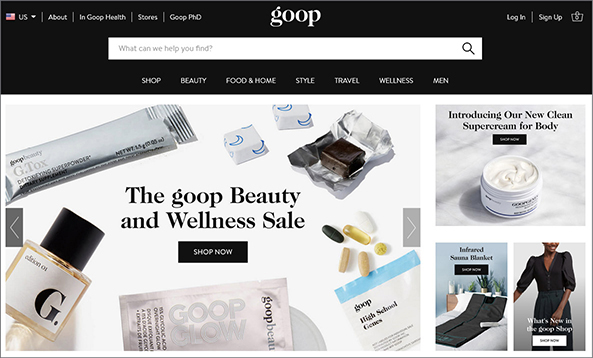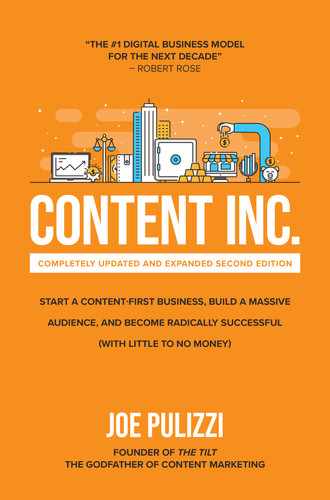![]()
CHAPTER 9
![]()
SELECTING YOUR PLATFORM
Subscription companies are growing nine times faster than the S&P 500. Why? Because unlike product companies, subscription companies know their customers. A happy subscriber base is the ultimate economic moat.
CONTENT TYPES
According to Content Marketing Institute/Marketing Profs research, the most popular content types used by businesses are as follows:
• Social media content
• Videos
• Blog posts or articles
• Email newsletters
• In-person events
• Webinars/online events
• White papers/e-books
• Print magazines
• Podcasts
This means that most businesses are creating mountains of just about every kind of content type on all sorts of platforms, sometimes simultaneously. Simply put, we need more focus.
The majority of Content Inc. success stories fall into the following content types:
• Articles, blogs, or content-based websites. When we launched the Content Marketing Institute, blogs were the main platform for building audience. Our blog posts started at three times per week and now run once per day.
• E-newsletter programs. One example, author and speaker Ann Handley’s e-newsletter Total Annarchy, a bimonthly guide on writing better, has garnered more than 30,000 subscribers in just a few years.
• Videos. In most cases, this means a regular YouTube series with a show at least once per week, or possibly a regular Twitch stream.
• Audio podcasts. Nathaniel Whittemore delivers a podcast on macroeconomics and bitcoin to fans every evening. His is becoming one of the most popular cryptocurrency podcasts in the industry.
• Instagram. Quinn Tempest launched her business, Create Your Purpose, on the back of daily Instagram postings.
• Facebook. Mette Løvbom from Denmark created SalatTøsen (The Salad Chick) almost exclusively on Facebook. Over the past five years, she has amassed more than 100,000 fans and launched an impressive line of salad-oriented products.
Companies that use Content Inc. strategies diversify their content channels into other properties once they attract large enough audiences. In the beginning, it’s important to focus on creating amazing and relevant content with mostly one content channel.
TRIAL AND ERROR
At the beginning of the worldwide pandemic in 2020, marketing author, speaker, and entrepreneur Joseph Jaffe launched CoronaTV, a live, interactive show with experts in multiple fields about how they are dealing with a life that isn’t normal.
Jaffe purposely launched on multiple platforms at once, including Facebook, LinkedIn, Periscope, and YouTube, to see which one would resonate the most.
When I first launched the Content Marketing Revolution blog, I also consistently distributed information on Twitter, LinkedIn, and Facebook. I dabbled a bit with YouTube as well. After a few months, once I started to see some results with the blog, I focused more energy there and used the social media channels as distribution points.
You might not know which platform will be the one when you begin your Content Inc. journey. There are many pros and cons to consider.
CHOOSING A PLATFORM
Consider three major questions when making a platform decision:
The first question is personal:
• How do you best tell your story? This means you, the human being, with all your gifts and talents.
In some cases, the best way to tell your story for your particular niche audience might be a podcast or a video series, but maybe you have more of a passion for writing or design.
For my Content Inc. platform, I believe the best platform would be a podcast, with regular interviews each week. The problem? I am more passionate about writing, so I focused on building the email newsletter as the main channel. How you like to create content matters.
The next two questions are all about reach and control.
• What channel offers you the best opportunity to reach your target audience? (Reach)
• What channel gives you the most control over presenting your content and building your audience? (Control)
Let’s look at the chart in Figure 9.1.

Figure 9.1 Your strategy will differ greatly depending on whether you start with control or reach.
Brian Clark’s Copyblogger has almost infinite control over its channel, a WordPress site that it owns. At the same time, Copyblogger needs to build a system to attract people to its content, since its website doesn’t reside within another ecosystem that can naturally bring it traffic. The same goes for Teach Better, one of the leading informational sites for teachers. It also launched its platform using WordPress.
On the other hand, Entrepreneurs On Fire (EOF, podcast) and Game Theory (video) have a greater reach possibility than Copyblogger, since they publish within an environment that has built-in audiences. EOF publishes mostly via Apple Podcasts and Spotify, where millions of people search for new podcasts every day. The same is true for Game Theory. Its target audience of gamers is already on YouTube every day. As long as Game Theory continues to create compelling content that YouTube will deliver, it should grow an audience there.
The problem with EOF and Game Theory is that they are leveraging platforms that they have little or no control over. Game Theory has more than 13 million subscribers. That’s amazing, but technically host and brand owner Matthew Patrick doesn’t control those subscriber relationships; YouTube does. YouTube could decide tomorrow that it doesn’t want Game Theory to have access to those people, or it might decide to publicize other content to Matthew’s audience, like PewDiePie or The Joe Rogan Experience, instead of Game Theory.
Consider the example of the duo SMOSH, one of the original YouTube sensations, who built an audience of 25 million subscribers on YouTube. After a few years of regular videos, SMOSH began to redirect the calls to action at the end of their videos, pushing viewers to their own website, Smosh.com, where they could sign up people for an email subscription program that they had control over.
If you choose a low-control channel as the main driver of your content distribution, be aware that at some point you’ll want to convert the subscribers on that platform to your own subscribers. If you choose a high-control channel, like a website or an in-person event, you’ll need to create a more robust plan to drive an audience to those venues.
BEWARE OF SOCIAL CHANNELS
Although social channels, such as TikTok, Clubhouse, Facebook, and LinkedIn, could be great places to build your digital footprint and followers, you ultimately have no control over what those companies do with your connections. Sure, LinkedIn lets your current connections see all the content you publish on LinkedIn, but LinkedIn changes its algorithm constantly. One day you might see thousands of people engage with your post. The next day it could be a few dozen. LinkedIn has every right to do so as a private business, and you, a free member of the LinkedIn community, have very few rights.
Social channels such as Facebook, Twitter, LinkedIn, Pinterest, Snapchat, TikTok, and Instagram may all be solid possibilities for building a platform, depending on whom you are targeting, but it’s important to understand the dangers.
CASE STUDY: TWINSTHENEWTREND
One of the biggest hits of 2020 was Twinsthenewtrend. Just about every day, a set of twin brothers sit and listen to a song they’ve never heard before, and we get to watch their reactions.
On July 27, the song was “In the Air Tonight” by Phil Collins. I implore you to watch it, especially their reaction at the 4:56 mark.
The song went completely viral, with 4 million views and more than 12,000 comments in just a few weeks.
But as you know, viral happens after delivering valuable content for a long period of time. The twins produced videos on YouTube for more than a year before they went viral. Many of their videos have just a few hundred views. Now the twins have gone internet famous and have amassed almost 700,000 subscribers on YouTube.
THE SAFEST BET
Look at the fastest-growing media companies of today, such as Morning Brew or the Bleacher Report, or more mature new media platforms, such as BuzzFeed. You can even look at a traditional publisher, like the New York Times. They are all very good at leveraging social channels and building an audience on those channels, but they don’t build their main platforms on social channels.
In every case, they build websites, mobile applications, print properties, or event programs (all with subscribers) that they can own, and then leverage other channels to drive people back to the sites they own, so they can convert passersby into an audience they can monetize.
PODCASTING ON A BUDGET
I’ve been podcasting since 2013. It’s hard to believe that includes more than 500 episodes of This Old Marketing (with Robert Rose) and the Content Inc. podcast.
When I first started, it took about two hours to produce each episode. Today, it takes about 20 minutes. Here are some tips:
1. Get a great microphone. This should actually be the first three points. A great microphone can make up for a lot. I use an Audio-Technica AT2020 USB and love it. My This Old Marketing cohost Robert Rose owns a Shure SM58, while podcaster Christopher Penn owns an AT2100.
2. Record with Audacity. Audacity is a free recording tool. It’s extremely easy to edit and publish. Once you create the file, save it as a .wav file and run it through another free program called Levelator II, which cleans up the sound. If you have an Apple, Garageband can replace Audacity.
3. Host with Libsyn. I’m a longtime customer of Libsyn, a podcast hosting and distribution platform. Robust plans start at $5 per month. Libsyn will distribute your podcast to Apple Podcasts, Spotify, Overcast, Stitcher, SoundCloud, YouTube, Amazon Music, Google, and more. Other platforms to consider are Buzzsprout, Podcave, Anchor, Podbean, and Captivate.
CONTENT TYPE/PLATFORM MATCH
Certain content types and storytelling styles match particular platforms and frequencies. Here are the formulas most used by Content Inc. entrepreneurs:

PLATFORMS IN ACTION
Openview invests in growth-oriented technology companies. Back in 2009, Openview launched a content platform that delivers regular article content to attract subscribers to an e-newsletter offering that now boasts more than 100,000 subscribers (Figure 9.2)—not bad for a venture capital company.

Figure 9.2 It’s been 10 years and 100,000 subscribers for Openview’s newsletter.
John Deere launched The Furrow magazine in 1895 (Figure 9.3). It is still published today in print and digital format in 14 different languages and distributed to 40 countries. The Furrow has always focused on how farmers can learn the latest technology to grow their farms and businesses.

Figure 9.3 John Deere’s The Furrow magazine is one of the oldest Content Inc. initiatives on the planet.
In the early 2000s, serial entrepreneur Jean-Baptiste Duquesne founded 750g as the leading food-recipe site for French food connoisseurs. Five years after launch, Duquesne expanded to Brazil, the United States, Italy, Spain, and Germany. Today, the community includes more than 4 million followers on Facebook and 400,000 followers on Pinterest, but its main platform is 750g.com.
Hollywood celebrity Gwyneth Paltrow launched her own Content Inc. strategy, called Goop. Originally conceived as a weekly e-newsletter of travel recommendations and shopping tips, Goop has evolved into a fully functioning media site with more than 8 million subscribers. It boasts a 40 percent e-newsletter open rate, or about twice the category average.

Figure 9.4 750g is the leading food-recipe site for French food connoisseurs.

Figure 9.5 Gwyneth Paltrow’s Goop now boasts more than 8 million subscribers.
RESOURCES
“Enterprise Content Marketing Research,” Content Marketing Institute/MarketingProfs, accessed October 10, 2020, https://contentmarketinginstitute.com/2020/02/customer-experience-enterprise-research/.
Interview with Jean-Baptiste Duquesne by Joakim Ditlev, September 2020.
McKinnon, Tricia, “The Growth Strategy Behind Goop,” accessed October 12, 2020, https://www.indigo9digital.com/blog/goopdirectoconsumerstrategy.
